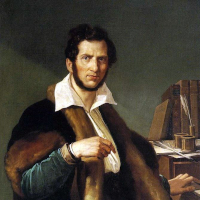

Gaetano Donizetti
Viva la Mamma!
Short instrumentation: 2 2 2 2 - 4 2 3 0 - timp, perc(3), str
Duration: 90'
Text bearbeitet von: Karlheinz Gutheim, Horst Goerges
Übersetzer: Karlheinz Gutheim, Horst Goerges, Michael Feingold
Dichter der Textvorlage: Antonio Simeone Sografi
Libretto von: Gaetano Donizetti
Bearbeitung: Vito Frazzi
Choir: TB
Roles:
Corilla Sartinecchi
soprano Stefano
baritone Luigia Boschi
soprano Agatha
bass Dorotea Caccini
mezzo-soprano Guglielmo Antolstoinolonoff
tenor Vincenzo Biscroma
baritone Orazio Prospero
bass The Impresario
baritone
Instrumentation details:
1st flute (+picc)
2nd flute
1st oboe
2nd oboe
1st clarinet
2nd clarinet
1st bassoon
2nd bassoon
1st horn
2nd horn
3rd horn
4th horn
1st trumpet
2nd trumpet
1st trombone
2nd trombone
3rd trombone
timpani
percussion(3)
violin I
violin II
viola
violoncello
contrabass
Donizetti - Viva la Mamma!
Sample pages
Audio preview
Work introduction
Viva la Mamma was originally a one-act farsa that was premiered at the Teatro Nuovo in Naples on 21 November 1827 with the title Le convenienze teatrali. Later on, Donizetti expanded it into a full-length opera buffa which was performed for the first time in Milan in 1831. Performances in German-speaking countries used a German translation and revision by Horst Goerges and Karlheinz Gutheim – based on Vito Frazzi’s original version for the Accademia Musicale Chigiana – through which the many gags in this parody of operatic life hit their mark more effectively. The work disappeared from repertoires as of the mid-19th century and was only rediscovered for the opera stage in the 1960s.
In his opera, the libretto of which is based on two single-act works by Antonio Sografi, Donizetti pokes fun at operatic life and all its intrigues, collisions and petty jealousies. The piece centres on the quarrelling among the members of an opera company which is preparing the Italian opera seria Romolo ed Ersilia with the intention of performing it in a provincial backwater. The audience experiences first-hand how the female singers fight amongst themselves and how the brash “Mamma” wants to secure as glamorous a role as possible for her daughter Luisa, the seconda donna. As fate would have it, this “Mamma Agata” ends up treading the hallowed boards herself as a singer, feeling for all intents and purposes like the new star of Italian opera. All of a sudden, however, the opera company gets word that the town requires a deposit from them before the performance is allowed to go ahead. Good advice is needed, as the company’s management is unable to come up with the sum in question. Mamma Agata donates her family jewels so that the financially beleaguered opera company can go ahead with its performance of Romolo ed Ersilia. All’s well that ends well! It turns out to be a remarkable stroke of luck to have Mamma Agata in the ensemble.
